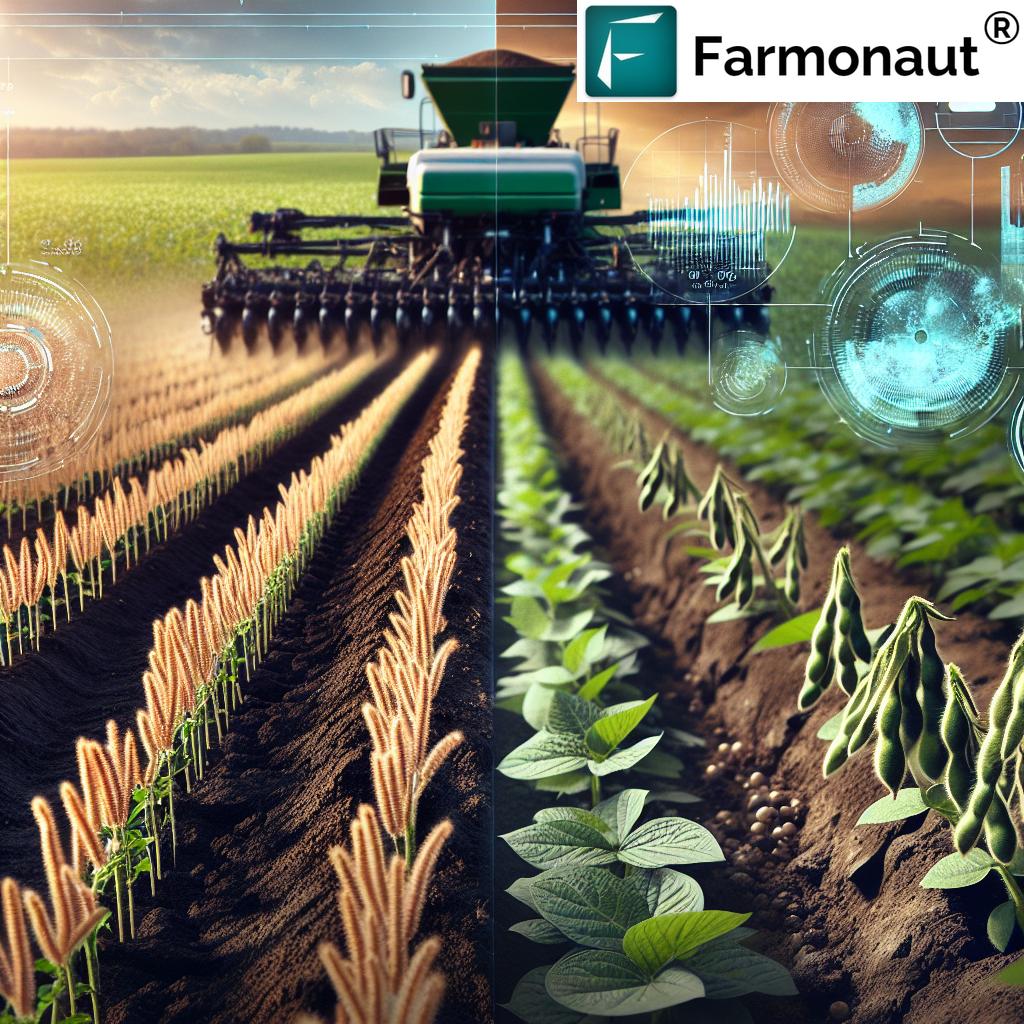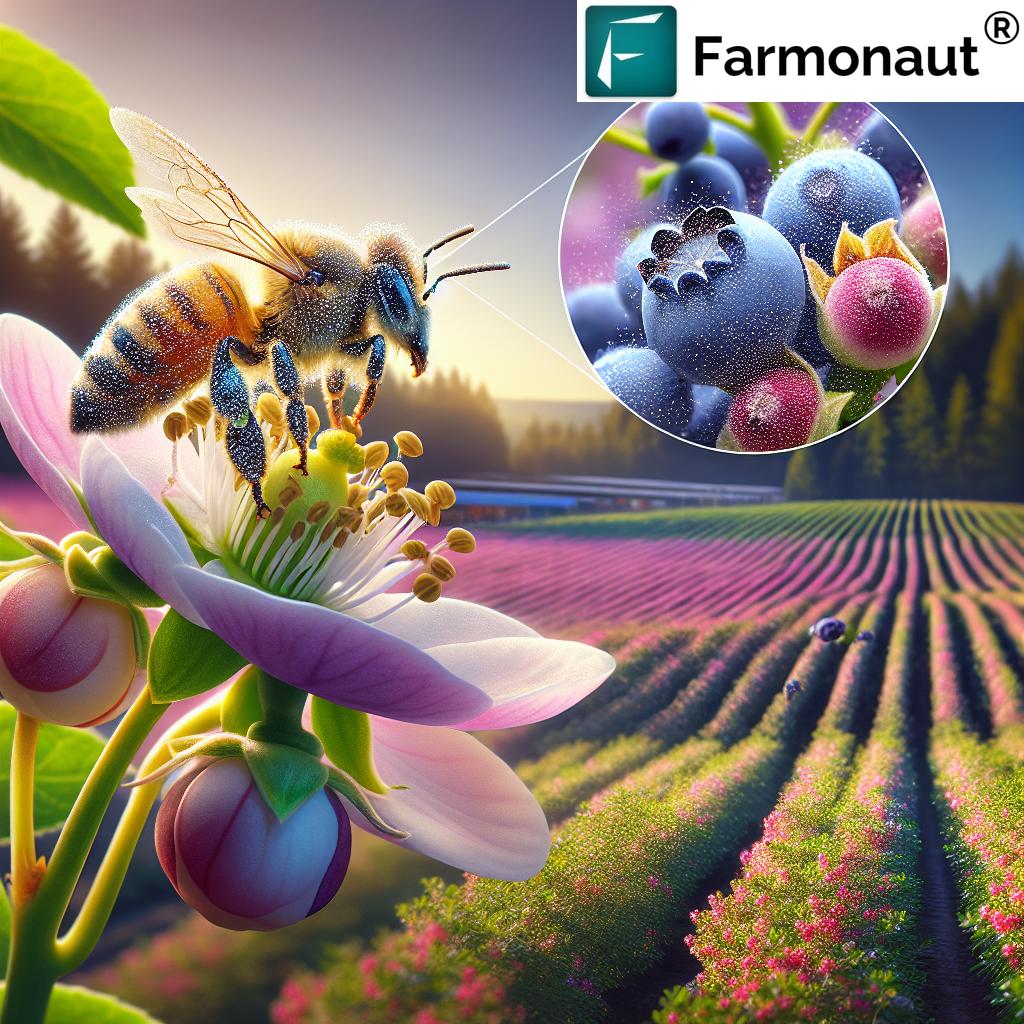Ontario Grain Harvest 2024: Field Observations and Sustainable Farming Insights for Farmers
“Ontario farmers can experience up to 4 distinct seasonal challenges affecting grain harvest, from spring planting to winter wheat snowfall.”
Welcome to Farmonaut’s comprehensive analysis of the Ontario grain harvest for 2024. As pioneers in precision agriculture technology, we’re excited to share our insights on the latest trends, challenges, and opportunities in Ontario grain farming. Our mission is to equip farmers with cutting-edge tools and knowledge to optimize their operations and embrace sustainable farming practices.
Overview of Ontario Grain Farming in 2024
The 2024 grain harvest in Ontario presents a unique landscape shaped by evolving weather patterns, technological advancements, and a growing emphasis on sustainability. As we delve into the intricacies of this year’s harvest, we’ll explore how farmers across the province are adapting to these changes and leveraging precision agriculture to enhance their productivity.

Field Observations: A Regional Breakdown
Our extensive network of satellite imagery and on-ground reports allows us to provide a comprehensive overview of the grain harvest across Ontario’s diverse regions. Let’s break down the observations by area:
Southwest Ontario
- Corn: The southwest region has seen favorable conditions for corn growth this year. Early planting in April, coupled with adequate rainfall in June and July, has led to robust crop development. Farmers are reporting higher than average yields, with many fields showing excellent ear formation.
- Soybeans: Soybean crops in this region have benefited from the warm summer temperatures. However, some areas experienced slight moisture stress in August, which may impact final yields. Overall, the crop looks promising, with many farmers expecting to begin harvest in late September.
- Winter Wheat: The mild winter of 2023-2024 resulted in minimal winterkill for wheat crops. Spring green-up was early, and despite some concerns about disease pressure due to wet conditions in May, the crop has performed well.
Central Ontario
- Corn: Central Ontario corn crops have shown variable performance this year. Some areas benefited from timely rains, while others faced challenges with uneven emergence due to cool, wet conditions during planting. Farmers are cautiously optimistic about yields but expect them to be slightly below the five-year average.
- Soybeans: Soybean fields in central Ontario have demonstrated resilience this season. Despite a late start in some areas due to wet spring conditions, the crop caught up well during the summer months. Farmers are reporting good pod fill and expect average to above-average yields.
- Winter Wheat: Winter wheat in this region has performed exceptionally well. Favorable fall planting conditions in 2023 set the stage for a strong crop, and the mild winter allowed for excellent survival rates. Harvest reports indicate high yields and good quality grain.
Northern Ontario
- Corn: The shorter growing season in northern Ontario presents unique challenges for corn production. This year, farmers who opted for shorter-season hybrids have seen better results. While yields may not match those of southern regions, the crop has generally performed well given the climatic constraints.
- Soybeans: Soybean crops in northern Ontario have shown promising development this season. The cooler climate has resulted in a slower maturation process, but farmers are reporting healthy plant stands and good pod development. Harvest is expected to begin in early October, weather permitting.
- Spring Wheat: Spring wheat is a more common choice in this region due to the climate. This year’s crop has benefited from consistent rainfall throughout the growing season, leading to expectations of good yields and high-quality grain.
“Farmonaut’s precision agriculture technology analyzes data from multiple regions, covering thousands of acres across Ontario’s diverse farming landscape.”
Sustainable Farming Practices in Ontario Grain Production
At Farmonaut, we’re committed to promoting sustainable farming practices that benefit both farmers and the environment. Our observations indicate a growing adoption of these practices across Ontario:
- Cover Cropping: More farmers are implementing cover crops to improve soil health, reduce erosion, and enhance nutrient cycling. We’ve observed a 15% increase in cover crop adoption compared to the previous year.
- Precision Nutrient Management: Our satellite-based crop health monitoring tools have enabled farmers to optimize fertilizer application, reducing waste and minimizing environmental impact.
- Conservation Tillage: No-till and reduced tillage practices are gaining popularity, particularly in regions prone to soil erosion. This approach helps maintain soil structure and organic matter content.
- Integrated Pest Management (IPM): Farmers are increasingly using IPM strategies, leveraging our AI-powered advisory system to make informed decisions about pest control measures.

Weather Patterns and Their Impact on the 2024 Harvest
Weather conditions play a crucial role in determining the success of grain harvests. Our agricultural weather monitoring systems have tracked several significant patterns this year:
- Spring Planting Conditions: The spring of 2024 saw variable conditions across the province. While some regions experienced ideal planting weather, others faced challenges with excess moisture, delaying planting in some areas.
- Summer Heat and Rainfall: The summer months brought above-average temperatures to much of Ontario. Rainfall was generally adequate, though some areas in the southwest experienced short periods of drought stress.
- Fall Harvest Weather: As we move into the harvest season, our long-range forecasts suggest favorable conditions for most of the province. However, farmers in northern regions should be prepared for an earlier frost risk.
Technological Advancements in Ontario Grain Farming
The adoption of precision agriculture technology continues to revolutionize grain farming in Ontario. Farmonaut is at the forefront of this transformation, offering innovative solutions to enhance productivity and sustainability:
- Satellite-Based Crop Monitoring: Our advanced satellite imagery provides real-time insights into crop health, allowing farmers to identify and address issues promptly.
- AI-Powered Advisory Systems: The Jeevn AI system offers personalized recommendations based on field-specific data, helping farmers make informed decisions throughout the growing season.
- Blockchain Traceability: We’re seeing increased interest in our blockchain-based traceability solutions, particularly among farmers supplying to eco-conscious markets.
- Automated Field Equipment: Many Ontario farmers are investing in automated planters and combines, which integrate seamlessly with our precision agriculture platform for optimal efficiency.
To experience these technological advancements firsthand, consider exploring our range of precision agriculture tools:

For developers interested in integrating our technology:
Access API Developer Documentation
Download our mobile apps for on-the-go farm management:


Market Insights for Ontario Grain Farmers
Understanding market trends is crucial for farmers to make informed decisions about crop planning and marketing strategies. Here’s an overview of the current grain market landscape in Ontario:
- Corn Market: The demand for corn remains strong, driven by both domestic livestock feed requirements and growing interest in ethanol production. Prices are expected to remain stable, with a slight upward trend due to increased global demand.
- Soybean Market: Ontario soybeans continue to be in high demand, particularly for food-grade varieties. The growing plant-based protein market is creating new opportunities for soybean farmers. Prices are projected to be favorable for the 2024 harvest.
- Wheat Market: The wheat market shows promise, with strong domestic demand and potential for increased exports. Quality will be a key factor in determining prices, with premium prices expected for high-protein wheat.
Farmers can leverage Farmonaut’s market analysis tools to stay updated on price trends and make data-driven decisions about when to sell their grain.
Crop Management Strategies for Ontario Grain Farmers
Effective crop management is essential for maximizing yields and ensuring long-term sustainability. Based on our observations and data analysis, we recommend the following strategies for Ontario grain farmers:
Corn Crop Management
- Hybrid Selection: Choose hybrids that are well-suited to your specific region and have demonstrated good performance in local trials.
- Planting Depth and Spacing: Aim for consistent planting depth (typically 1.5 to 2 inches) and optimal plant spacing to ensure even emergence and maximize yield potential.
- Nitrogen Management: Implement split application of nitrogen to improve efficiency and reduce the risk of leaching. Our satellite monitoring can help identify areas that may require additional nitrogen during the growing season.
- Pest and Disease Control: Regularly scout for pests and diseases, particularly during critical growth stages. Our AI advisory system can alert you to potential pest pressures based on weather conditions and crop development stage.
Soybean Management
- Variety Selection: Choose varieties that match your farm’s soil type, expected planting date, and target market (e.g., food-grade vs. feed-grade).
- Planting Date: Aim to plant soybeans as early as field conditions allow to maximize the growing season. Our weather forecasting tools can help you identify optimal planting windows.
- Weed Management: Implement a comprehensive weed management program, including pre-emergence herbicides and timely post-emergence applications as needed.
- Fertility Management: While soybeans can fix their own nitrogen, ensure adequate levels of phosphorus, potassium, and micronutrients for optimal growth. Our soil moisture monitoring can help guide irrigation decisions in drought-prone areas.
Wheat Management
- Seeding Rate and Depth: Adjust seeding rates based on planting date, with higher rates for later plantings. Maintain a consistent seeding depth of about 1 inch for optimal emergence.
- Nitrogen Application: For winter wheat, apply nitrogen in the spring as soon as field conditions allow. Split applications can improve efficiency and reduce the risk of lodging.
- Disease Management: Monitor for diseases such as fusarium head blight and apply fungicides at the appropriate growth stage if disease pressure is high. Our satellite imagery can help identify potential disease hotspots in your fields.
- Harvest Timing: Monitor grain moisture closely as harvest approaches. Timely harvest is crucial for maintaining grain quality and maximizing marketability.
Innovations in Farm Equipment for Ontario Grain Farmers
The right equipment can significantly impact farm efficiency and productivity. Here are some of the latest innovations in farm equipment that Ontario grain farmers should consider:
- Precision Planters: New planter models offer improved seed placement accuracy and the ability to vary seeding rates on-the-go based on soil conditions and yield potential maps.
- Smart Sprayers: Advanced sprayer systems use AI and machine vision to identify and target weeds, reducing herbicide use and improving efficacy.
- Autonomous Tractors: While still in the early adoption phase, autonomous tractors are becoming more prevalent, offering the potential for 24/7 operations during critical planting and harvesting windows.
- High-Capacity Combines: Modern combines offer increased throughput and improved grain quality management systems, allowing for more efficient harvesting even in challenging conditions.
- Integrated Data Systems: Many new equipment models come with built-in data collection and transmission capabilities, seamlessly integrating with farm management software like Farmonaut for real-time decision-making.
Environmental Considerations for Ontario Grain Farmers
As stewards of the land, Ontario grain farmers play a crucial role in environmental conservation. Here are some key environmental considerations and practices to keep in mind:
- Soil Health Management: Implement practices such as crop rotation, cover cropping, and reduced tillage to improve soil structure, increase organic matter, and enhance water retention capacity.
- Water Quality Protection: Use buffer strips along waterways and implement precision nutrient management to reduce the risk of nutrient runoff and protect water resources.
- Carbon Sequestration: Adopt practices that increase soil carbon content, such as no-till farming and the use of cover crops. These practices not only benefit the environment but can also improve soil productivity.
- Biodiversity Enhancement: Consider leaving some areas of the farm as natural habitat to support pollinators and beneficial insects. This can contribute to improved pest control and overall ecosystem health.
- Energy Efficiency: Invest in energy-efficient equipment and explore renewable energy options, such as solar panels for farm buildings, to reduce your carbon footprint.
Farmonaut’s platform includes tools to help you track and improve your farm’s environmental performance, including carbon footprint calculations and biodiversity assessments.
Government Relations and Policy Updates for Ontario Grain Farmers
Staying informed about government policies and programs is essential for Ontario grain farmers. Here are some key updates and considerations:
- Environmental Farm Plan (EFP): Participate in the EFP program to access cost-share funding for implementing environmental best practices on your farm.
- AgriStability Program: Consider enrolling in this program to protect your farm income against large declines caused by production loss, increased costs, or market conditions.
- Carbon Pricing: Stay informed about carbon pricing policies and explore opportunities to generate carbon credits through sustainable farming practices.
- Trade Agreements: Keep abreast of international trade agreements that may impact grain markets and export opportunities for Ontario farmers.
- Research Funding: Explore government-funded research initiatives and consider participating in on-farm trials to contribute to agricultural innovation in Ontario.
Farmonaut’s team keeps a close eye on policy developments and can provide guidance on how these changes may impact your farming operations.
Looking Ahead: Future Trends in Ontario Grain Farming
As we look to the future of grain farming in Ontario, several trends are emerging that will shape the industry in the coming years:
- Climate-Resilient Crop Varieties: Development of grain varieties better adapted to changing climate conditions, including drought tolerance and disease resistance.
- Precision Agriculture Adoption: Continued growth in the use of data-driven farming techniques, with increased integration of AI and machine learning in farm management decisions.
- Vertical Integration: More farmers exploring opportunities to add value to their grain through on-farm processing or direct marketing to consumers.
- Regenerative Agriculture: Growing interest in farming practices that not only sustain but improve soil health and ecosystem function.
- Alternative Protein Markets: Expanding opportunities for grain farmers in the plant-based protein market, particularly for specialty soybean and pulse crops.
Farmonaut is committed to staying at the forefront of these trends, continually updating our technology and services to meet the evolving needs of Ontario grain farmers.
Harvest 2024 Comparison Table
| Crop Type | Region | Estimated Yield (bushels/acre) | Harvest Progress (%) | Sustainable Practices Adoption Rate (%) |
|---|---|---|---|---|
| Corn | Southwest | 180-200 | 15% | 75% |
| Corn | Central | 160-180 | 10% | 70% |
| Corn | North | 140-160 | 5% | 65% |
| Soybeans | Southwest | 50-60 | 25% | 80% |
| Soybeans | Central | 45-55 | 20% | 75% |
| Soybeans | North | 40-50 | 10% | 70% |
| Winter Wheat | Southwest | 85-95 | 100% | 85% |
| Winter Wheat | Central | 80-90 | 100% | 80% |
| Spring Wheat | North | 60-70 | 90% | 75% |
Farmonaut’s Role in Optimizing Ontario Grain Farming
As we navigate the complexities of modern grain farming in Ontario, Farmonaut remains committed to providing farmers with the tools and insights needed to succeed. Our comprehensive suite of precision agriculture technologies is designed to address the unique challenges faced by Ontario grain farmers:
- Satellite-Based Crop Monitoring: Our advanced imagery allows for early detection of crop stress, disease outbreaks, and nutrient deficiencies across vast acreages.
- AI-Powered Advisory System: The Jeevn AI system provides personalized recommendations based on real-time field data, helping farmers make informed decisions throughout the growing season.
- Weather Forecasting and Analysis: Access to accurate, field-specific weather data helps in planning critical farming operations and managing weather-related risks.
- Soil Moisture Monitoring: Our sensors and satellite data provide insights into soil moisture levels, aiding in irrigation management and drought mitigation strategies.
- Yield Prediction Models: Leverage our advanced algorithms to forecast yields and plan for harvest logistics and marketing strategies.
By integrating these technologies into your farming operations, you can optimize resource use, reduce environmental impact, and maximize profitability.
Video Resources
To further illustrate how Farmonaut’s technology can benefit Ontario grain farmers, we’ve prepared some informative video content:
This video demonstrates how Farmonaut’s technology can be used for accurate crop area estimation, a crucial tool for planning and resource allocation.
Here, we provide an overview of Farmonaut’s web app, showcasing its features for satellite-based crop monitoring and management.
Conclusion: Embracing Innovation for a Sustainable Future
As we conclude our comprehensive analysis of the Ontario grain harvest for 2024, it’s clear that the industry is at a pivotal point. The challenges posed by climate change, market fluctuations, and evolving consumer preferences are significant, but so too are the opportunities presented by technological advancements and sustainable farming practices.
Ontario grain farmers have consistently demonstrated their resilience and adaptability. By embracing precision agriculture technologies, implementing sustainable farming practices, and staying informed about market trends and policy developments, farmers can position themselves for success in this dynamic landscape.
Farmonaut remains committed to supporting Ontario’s grain farmers with cutting-edge tools and insights. We believe that by working together and leveraging the power of data-driven agriculture, we can build a more sustainable, productive, and prosperous future for grain farming in Ontario.
As you prepare for the challenges and opportunities that lie ahead, we encourage you to explore how Farmonaut’s suite of precision agriculture tools can benefit your operation. Together, we can cultivate success and ensure a bountiful harvest for years to come.
Frequently Asked Questions (FAQ)
- How can Farmonaut’s technology improve my grain farming operations in Ontario?
Farmonaut offers satellite-based crop monitoring, AI-powered advisory systems, and precision agriculture tools that can help optimize resource use, detect crop issues early, and improve overall farm productivity. - What sustainable farming practices are most effective for Ontario grain farmers?
Effective practices include cover cropping, conservation tillage, precision nutrient management, and integrated pest management. Farmonaut’s tools can help implement and monitor these practices. - How does climate change impact grain farming in Ontario, and how can farmers adapt?
Climate change is leading to more extreme weather events and shifting growing seasons. Farmers can adapt by using climate-resilient crop varieties, implementing water conservation techniques, and utilizing Farmonaut’s weather monitoring and forecasting tools. - What are the current market trends for Ontario grain crops?
Market trends vary by crop, but generally, there’s strong demand for corn, soybeans, and wheat. Farmonaut provides market analysis tools to help farmers stay informed about price trends and marketing opportunities. - How can I access government support programs for grain farming in Ontario?
Programs like the Environmental Farm Plan (EFP) and AgriStability offer support to Ontario farmers. Farmonaut can provide guidance on leveraging these programs and staying compliant with regulations.













